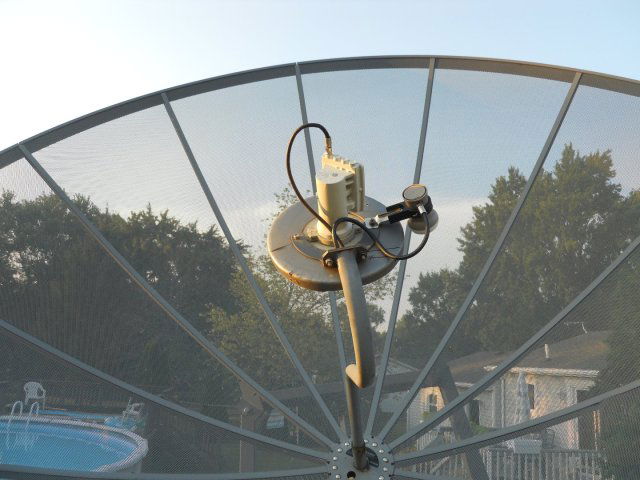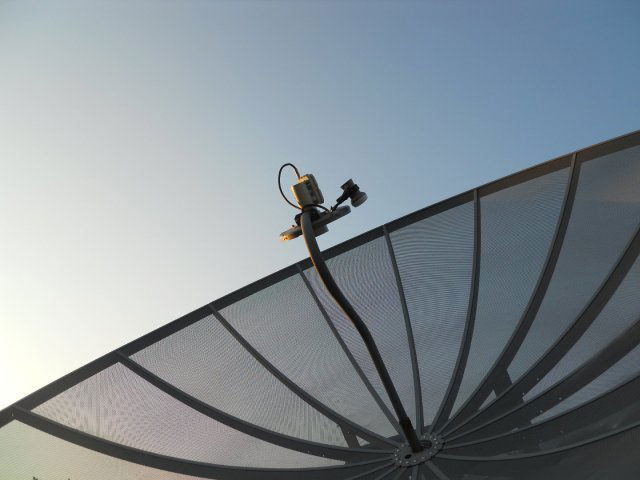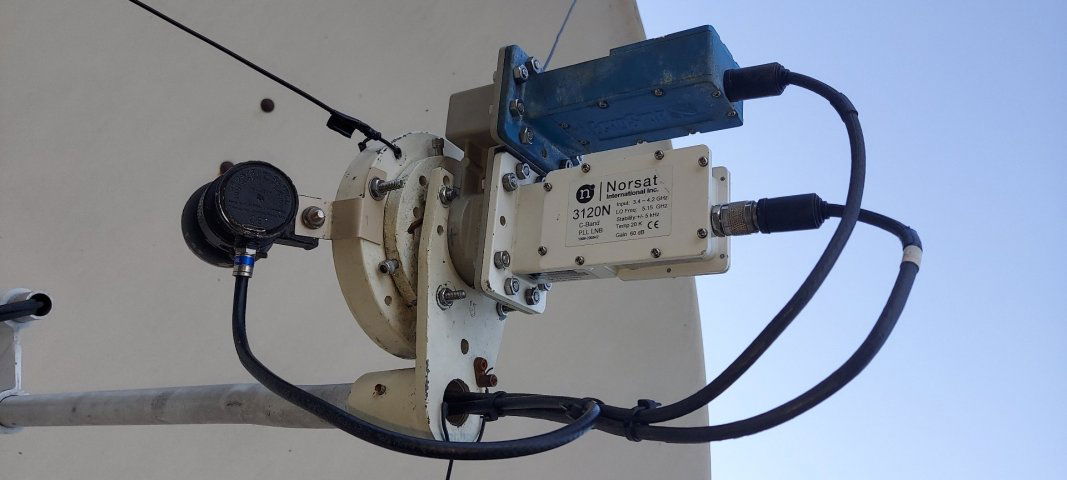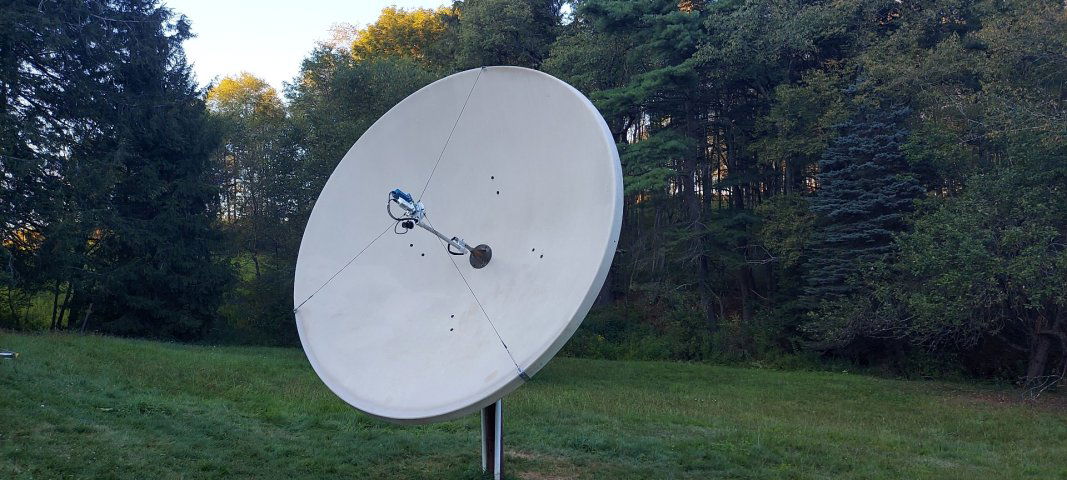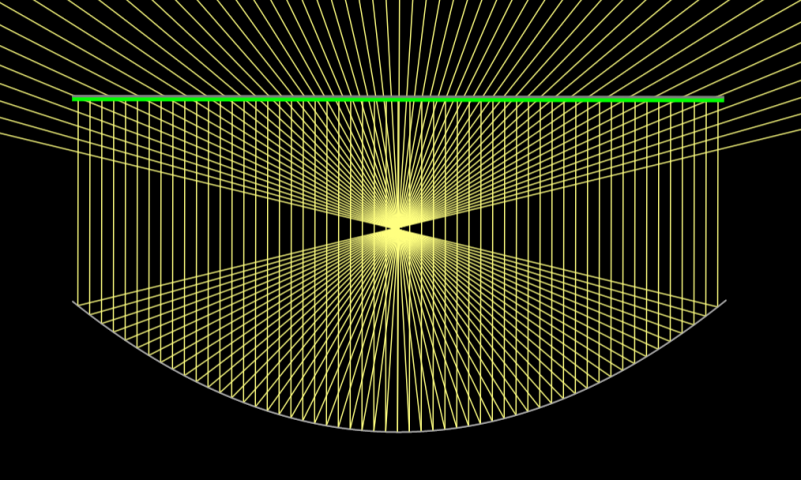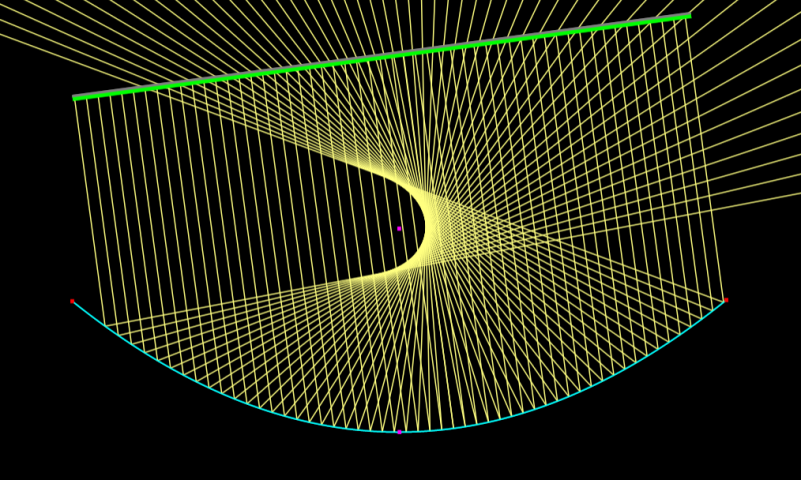I apologize that mathematics is so onerous. Like Barbie, we should all go shopping instead.
Unfortunately, the arithmetic is so boring and tedious that even the lawyers liked it and decided to codify it 42 years ago. Uncle Sam, say it isn't so!

www.ecfr.gov
Title 47 (Telecommunication) / Chapter I (Federal Communication Commission) / Subchapter B (Common Carrier Services) / Part 25 (Satellite Communications) / Subpart C (Technical Standards) / Subsection 25.209 (Earth station antenna performance standards)
Like seriously, what a way to wreck a party. Sheesh.
The ray optics ("applied math") simulator was handy to create the following images. First, we have a prime focus parabola with the focal point outside the reflector depth. Second, we have a prime focus parabola with a signal at an offset angle. I exaggerated the angle for illustration purposes. Whether the incident signal changes angle or the reflector changes angle, it is the same effect. The focal point changes into a crescent-shaped wavefront of varying constructive interference with an increasing void in between the wavefront and the parabola's natural focal point. This is the Ku offset LNB "where to position it?" issue.
The purple dot is the focal point. For a 2-degree reflector, the signal strength at that location is going to drop off at a previously-described mathematical rate. To the right of that wavefront? Well, one might describe the signal levels as "increasingly muddy".
In the offset image, only a fraction of ray merge immediately horizontally right of the focal point. That's the "4-foot effect". The efficiency of the reflector diminishes quickly when not at the focal point. Because all of the ray that converge at that location are source from points inside the dish, the angle of the Ku stepped conical scalar rings could be drawn in, further illustrating the concept of illumination limitations. It is also possible that removal of the Ku stepped scalar entirely might improve signal gathering. Hack saw exercises and experimentation are left to the reader.
Others have noted they are nudging the dish positioners sufficiently to be a number of degrees off the original target boresight. The point of that is to attempt to peak the wavefront. It has a point of diminishing returns because, well, you're now running essentially an offset reflector with gain parameters based on a parabolic mechanical equation rather than an elliptical equation. You aren't trying to hit a new focal point; you're trying to maximize a relative position in a goofy wavefront. Because we only use hand tools and not pesky math, we have to experiment with where to position the Ku LNB and how to adjust the reflector azimuth. <whisper> If someone wanted to know where to nudge their positioner, though, I would suggest that the arctan of (Ku offset from natural focal point / focal length) might be a good starting point. </whisper>
This is the illustrated HOW and WHY of antenna and offset LNB performance for prime focus systems. I apologize to all readers for using my 30+ years of experience in electrical engineering, mathematics, and RF regulatory filings for terrestrial microwave systems designed to five and six 9s availability. I will not derive anything from first principles again. I know that I have hurt many people with my HP RPN calculators and graph on log paper. I also apologize to all female techies for the joke. (Let's go shopping regardless.)
Everyone else's mileage may vary.
Firstly the link is working with a true parabola. My higher education was squelched after high school. That's another story for another time.
I didn't wreck the party. I brought the Jager AND the weed. When needed I really love reading textbooks with theory.
Just that, well, when verbiage in one paragraph leads to the next half of the page with algebraic, calculus, the Greek symbols. The things you see in the movies where the geeks are up on ladders in front of a huge blackboard with chalk and white sleeves used as erasers.
Not my forte'. Education and knowledge is awesome. But all of the math in the world in one shot, in a stack of documents.
In that world. Men would have been on the moon in 1964 in a rocket that launched perfectly the first time. And nobody would have died in the process. All of the engineering degrees and sheepskins on the wall could not attain that.
I like the Nike approach. Just do it. With a bit of background, of course. People hate Elon. Well, Elon didn't do it. Him and his well picked team did it. Right?
A Chaparral feed with polorotor, a feed with four independent flanges for two c and 2 ku band rf amplifiers integrated that utilizes a single microwave waveguide would be the correct and only apparent way to achieve the desired "" in a book-proper way.
So, a dude spends a gazillion bucks and does it proper. And finds out that ku-band simply......sucks.
He already has a very good working c band setup. 10-20 bucks and some elbow grease. Ba-Da-Bing!!
That's all I'm trying to get across.
True parabola. The only one I was taught in school. If it's not true, it ain't a parabola. And the rules apply.
The simulator just let's you play around to see what happens if you change offset angles. Or like Hypercasey did, which I like, DON'T shoot over the center and use the same side of the dish for the offset.
And, as mentioned. I DID remove the first "step" in the ku lnbf. With minimal, if any at all, signal improvement.
Thinking that doing it would increase the illumination angle. If that's the correct terminology that is in "The Book" for which I briefy skimmed over.
Stacks of paper ain't-a- gonna' tell you to slap that baby there and it will work like a peach.
Same for me with my aged dish.
Direct c/p:
Focal length = f
Depth = c
Diameter = D
f = ( D * D ) / ( 16 * c )
Well. Discussed before somewhere here in the archives. I got Mr. Rusty set back up after years of setting.
Got an lnbf from Brian, a receiver from somewhere.
Did the math. Slapped the feed and scalar exactly where the math said to. I mean exactly. I like fabricating and building "stuff" to sometimes exacting measurements, tolerances. This is not a NASA dish. It was probably made from some yaznooks in an old sawmill with a plaster of Paris mold and fiberglass and metal sprayer like is used to build up worn bearing surfaces prior to re-machining.
But it works!
AFTER playing around with the feed distance and scalar distance.
See the guy wires? Railing turnbuckles to fix sag from years of just setting at zenith so my old man could mow the yard.
3 strings across the face showed around on-eight's inch separation. Found what it took to make it nil.
Fixed it.
The polar axis sag. Tighten the turnbuckle to remove guy wire slack at the 4 o'clock position.
The noon guy is static currently. Set to just slightly tension it.
Adjust the third turnbuckle to just take up the slack.
After first boresighting the feed and making sure the scalar was equidistant from the dish edges and parallel to the face.
The polar axis turnbuckle tightened...maybe....3-4 turns boosted signal from in the 11 dB range to 14 dB. Other c band tp's floor my osmio4k at over 18 dB.
Did I do good? Pg. 481, section 3, paragraph two.
In the real world, the "books" would say "Toss it, it ain't no good". Am I, will I, did I? The authors are enjoying some real yellow and nasty-tasting Wheaties right about now. Right about now, the funk-soul brother. Lol.
Me? I ain't touched, phased. I had and still do respect good mentors and teachers. I really wish I had the opportunity for higher education.
Then you have people like Charlie Kirk saying higher education in the 2020's is a farce. Companies are hiring talent in lieu of 8 year university grads with so many degrees that they can't even change a toilet flapper or change a tire.
I disagree. RPN? A slide rule? Just a few minutes with them out again and I'm there, dude.
You have to agree though. Typing in "Online <choose your topic> calculator, simulator" is really, Really cool.


